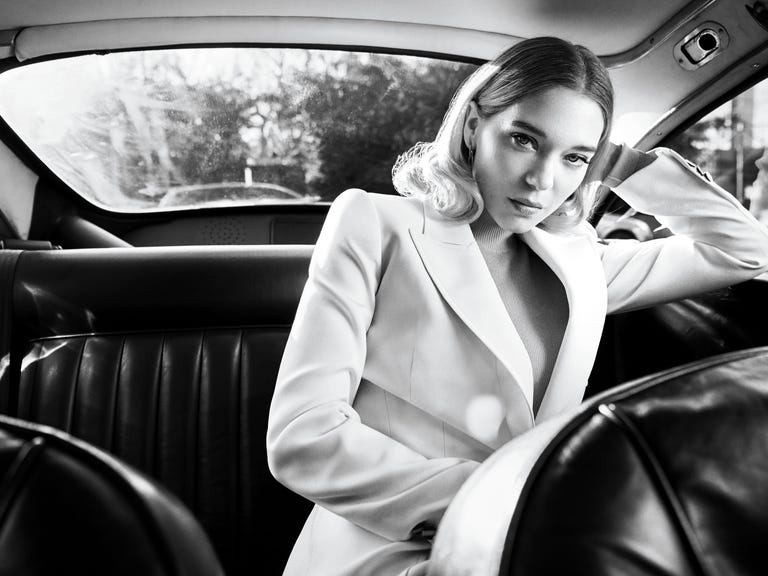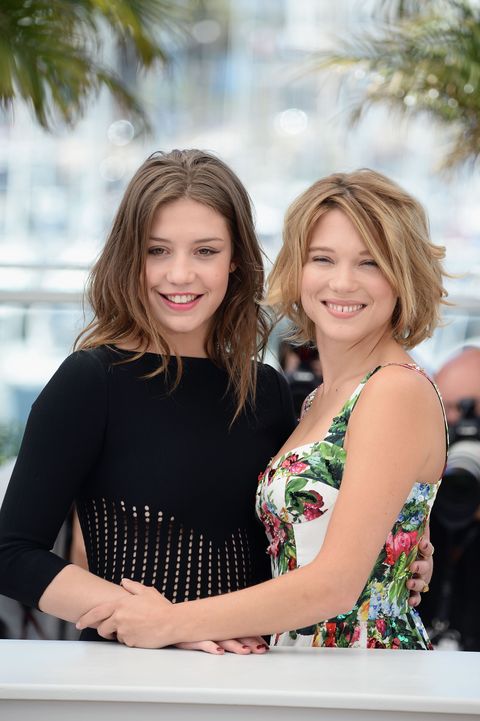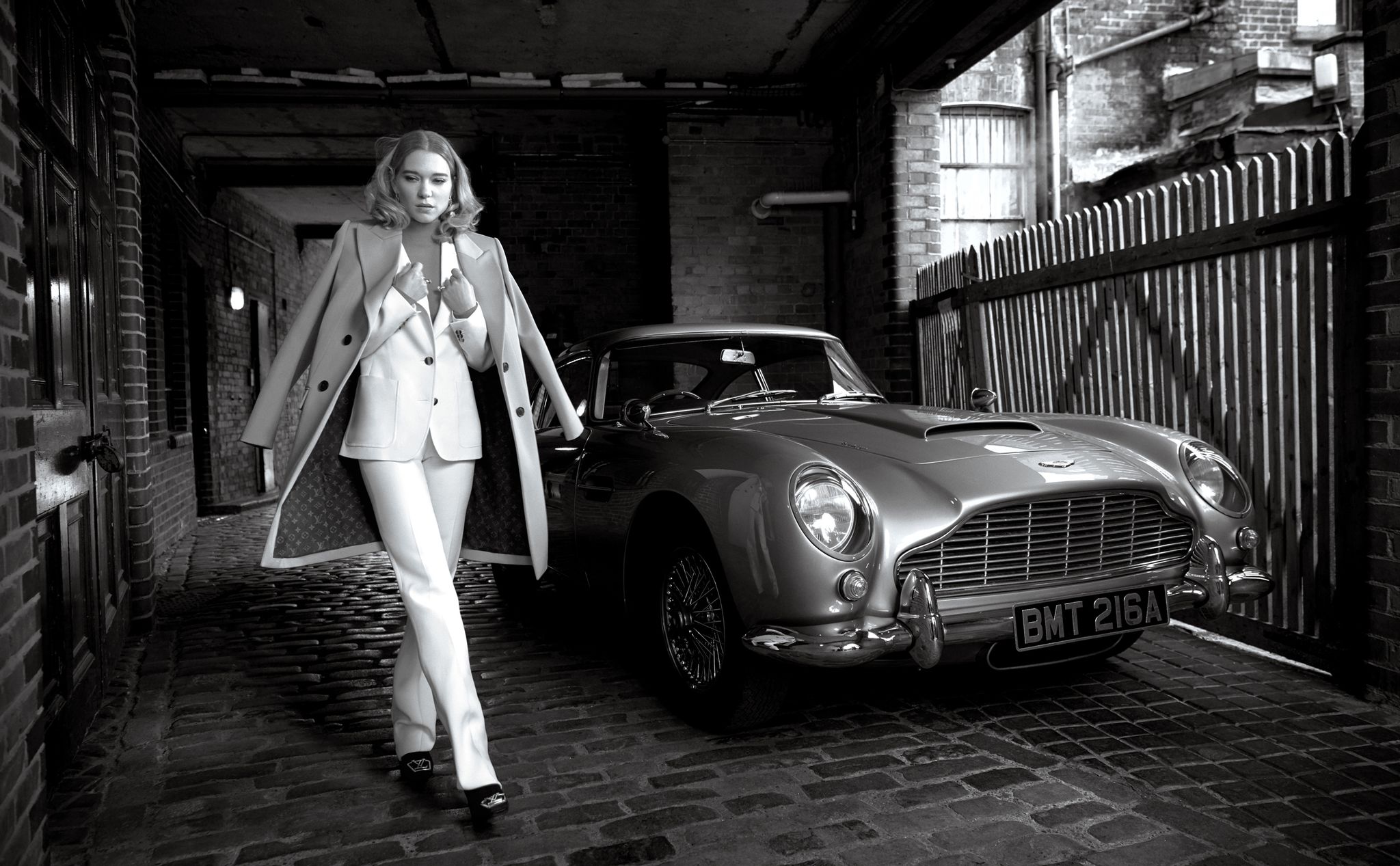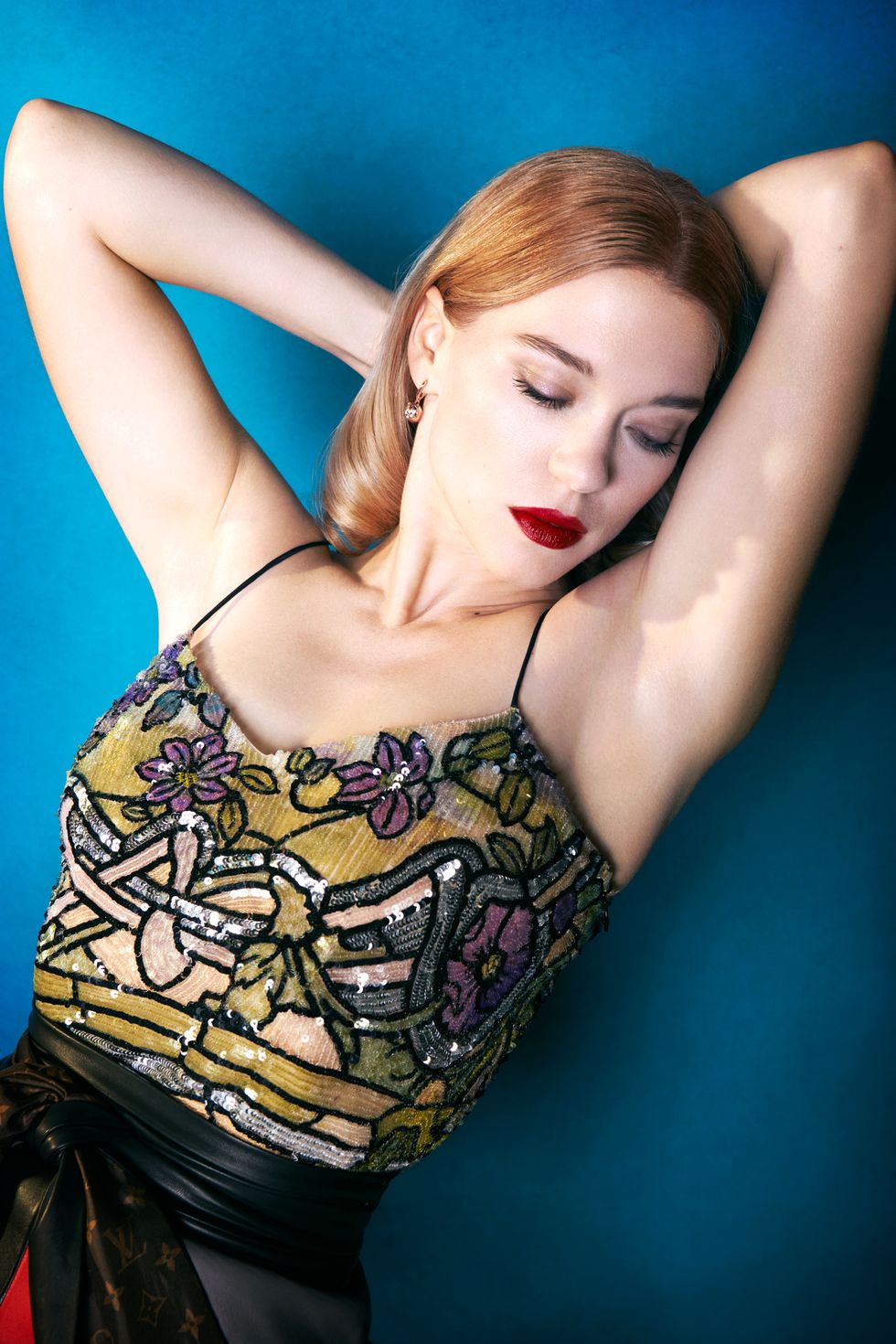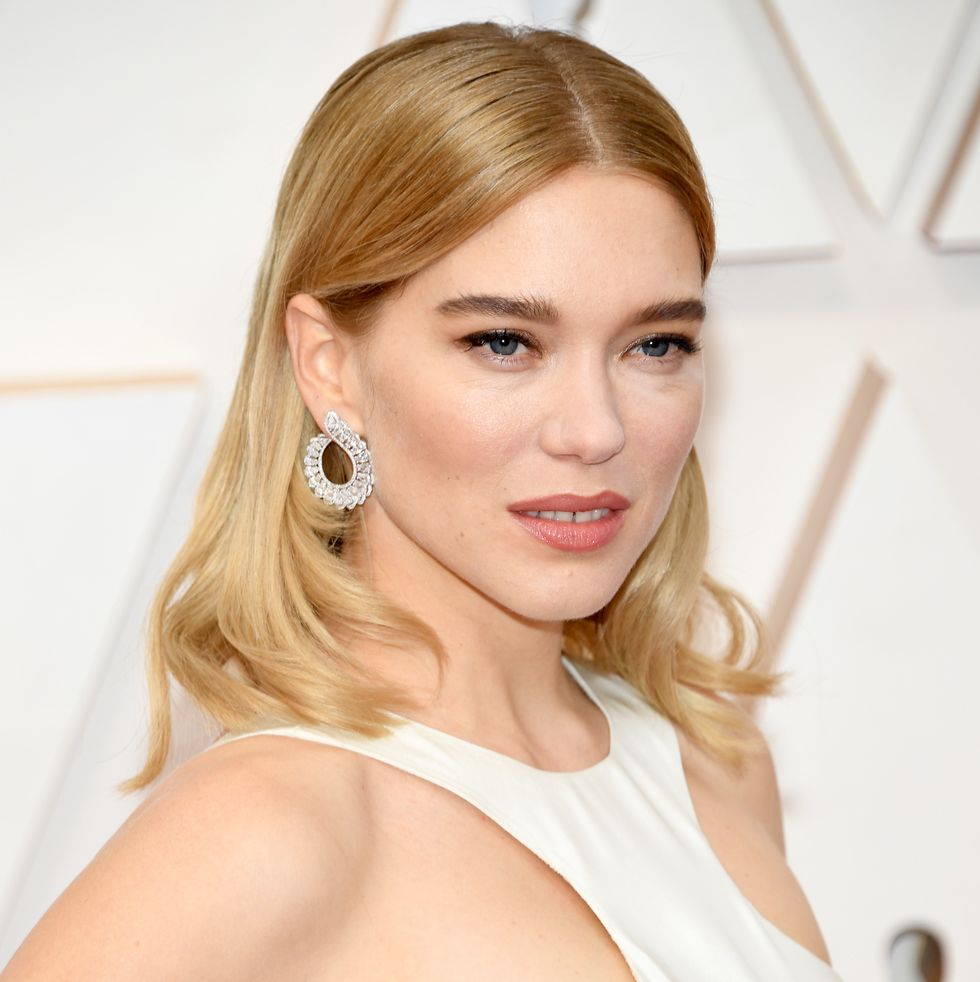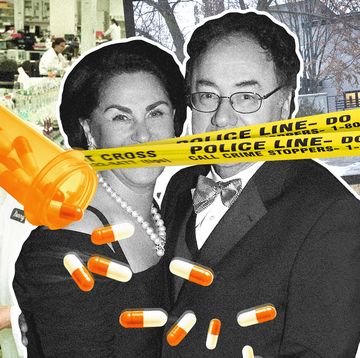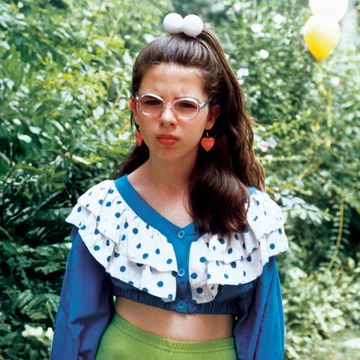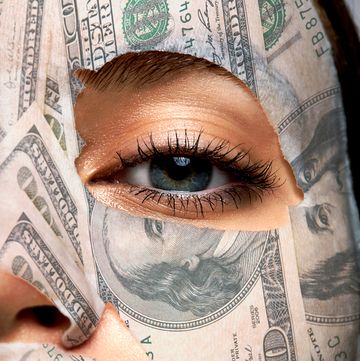After more than a year of delays, No Time to Die—the 25th James Bond film—is finally hitting theaters. Directed by Cary Joji Fukunaga and starring Daniel Craig, Léa Seydoux, Ana de Armas, and Rami Malek, the film had its world premiere at London’s Royal Albert Hall on September 28, just a week before it will land on movie screens around the world. Back in March 2020, when the film was originally set to release, Town & Country featured Seydoux, the French star who plays Dr. Madeleine Swann in a stunning cover story. In celebration of the film’s release, we’re revisiting it now.
Léa Seydoux isn’t interested in intentions. It’s a gray afternoon in early January, the time of year when the rest of the world is setting resolutions, but the French actress says that, for now, her plan for 2020 is not to make many. In the past 12 months she has shot four films in rapid succession, and what she’s most eager for is a break.
We’re seated in a hotel bar in the shadow of the Louvre, and the 34-year-old Parisian is relaxed in a leather armchair, legs crossed, hands folded in her lap. Her pale face is bare and framed by her honey-colored hair, tousled yet tidy and falling shoulder-length to graze her oversize ski sweater. “For now I have nothing, no projects,” she says. “And I don’t want to work. I want to have time for myself.”
Seydoux’s slate started filling up this time last year, with Wes Anderson’s The French Dispatch, in which she joined an ensemble cast telling the story of an American magazine's French outpost. Then it was directly on to Budapest to film Ildikó Enyedi’s The Story of My Wife, in which Seydoux plays a Hungarian naval captain’s spouse. That was followed by the latest James Bond movie, No Time to Die, in which she reprises her role as 007’s steely love interest, Dr. Madeleine Swann, and finally Bruno Dumont’s On a Half Clear Morning, which stars Seydoux as a war reporter whose life is overturned by a car accident.
All will be released in 2020, and other than the Bond film (due in theaters November 25 [This was moved from an original April 10 release date—Ed]), they might all be in the Cannes Film Festival in May. “I’m really excited. I think they are brilliant films,” she says with a mixture of calm and zeal. “It would be great if they were all in Cannes.”
It was at Cannes seven years ago that Seydoux’s film Blue Is the Warmest Color made festival history when Steven Spielberg, president of the jury that year, made the unprecedented decision to award the Palme d’Or, the festival’s highest prize, not only to the director, Abdellatif Kechiche, but to the film’s two young stars, Seydoux and Adèle Exarchopoulos. (The actresses joined Jane Campion as the only women ever to receive the award.)
Seydoux was already an emerging darling of French cinema, thanks to such films as Farewell, My Queen and smaller parts in American films such as Quentin Tarantino’s Inglourious Basterds, but it was her performance as a lesbian art student on the brink of adulthood that cemented her reputation as one of France’s next generation of leading talents. (She and Exarchopoulos later accused Kechiche of abusive on-set behavior, but in the Pre-Too era they were largely ignored.)
This was followed by the release of her first Bond film, Spectre, in 2015. Seydoux’s performance as the spy’s latest love interest brought her international acclaim, and she became a face of Louis Vuitton, returning to Cannes in 2018 as a jury member. Her Swann, a sharpshooting psychiatrist, is not your average Bond girl. “I can look after myself, ” she tells 007 at one point, later saving him from being pushed out of a moving train. “For me, Léa is not a Bond girl,” says Wes Anderson. “She is more like M or Q or Felix Leiter, part of that ensemble, just dressed in aquamarine silk.”
He cites as evidence her return to the part—one of the very few times in the franchise’s history that a female lead has reprised her role: “They don’t usually bring the Bond girls back for the next picture, if you see what I mean.”
But there has never been a Bond girl quite like Seydoux. “Léa has a gift for mystery, ” says Phoebe Waller-Bridge, who co-wrote the latest Bond script. “Which I think is one of the most powerful tools an actor can possess. She can do very little, and we are enraptured. She holds things back, so we lean in. You can feel her intelligence and her intensity through the screen.”
However, going from one emotionally draining role directly into the next took its toll on the actress. “This year was crazy, ” she says, “because I worked nonstop. I have to say it was too much.” But she isn’t complaining about her peripatetic life. “I’ve always wanted to travel. For me it’s part of the joy of being an actress.” In fact, she has returned this morning from a Caribbean vacation with her three-year-old son, George, her child with her partner, banking scion André Meyer.
“I think being an actress is also good because you can work very intensively for a few months and then have a month where you’re off and you can have a normal life. It suits me in a way. My goal right now is to read books,” she says. She’s beginning with Madame Bovary, although today she’s carrying a Neville Thompson paperback in the pocket of her shawl-collar shearling coat.
She also dreams of learning to cook and taking up gardening; her house in the Montparnasse neighborhood has a back yard. “I love living in Montparnasse, because it’s not fancy,” she says. “I can disappear. I love to disappear. I may be the only actress who doesn’t want to be seen.”
Seydoux grew up near the Luxembourg Gardens, in Saint-Germain-des-Prés, one of seven kids in a Brady Bunch–style mixed tribe descended from one of France’s most prominent industrial families. Seydoux has been open about her complicated feelings about her upbringing. “I’ve always had very strong views on how I was raised,” she says; in the past she has said she felt like an orphan. Her parents split when she was three.
Her mother Valérie Schlumberger, an actress turned philanthropist, spends half the year in Senegal, where she runs a local nonprofit. Her father Henri Seydoux, a telecommunications magnate, was often away working, the actress says. Her grandfather and great-uncle run Pathé and Gaumont, respectively, the two oldest and largest film companies in France.
Journalists are quick to peg her as cinema royalty, suggesting that nepotism accounts for her success. But she is insistent that it had nothing to do with her career. She fell into acting by chance when she accompanied a boyfriend on an audition. (She originally wanted to be an opera singer and briefly studied at La Conservatoire de Paris. “I had a beautiful voice, actually,” she says, “but no rigor.”)
She was the first in her family to pursue acting seriously, and initially her relatives were skeptical. She has kept her distance from them professionally, but she understands why people are eager to make the connection. “You have to place the object in context,” she says. “They have to put people in boxes, and the reality is much more complex, always.”
Her father used to take her and her sister Camille, a stylist, to museums on weekends when they were girls, often the Egyptian art wing at the Louvre. “It’s the only thing he did,” she says flatly. He explained to her that artists put their emotions into their art, that that is what you see on the canvas. “It’s always like you have to… Tu doit mettre ta chair sur la table,” she says, an expression that translates as “You must put your flesh on the table.” It is a maxim she takes to heart. “It’s true you have to expose yourself—that’s cinema.”
Seydoux has applied this early lesson to her own work with gusto. “For me movies are about life. So of course you use your own experience.” She continues, “So it’s more difficult to do films like Mission: Impossible. I find it harder than intimate films, because, for me, cinema is about intimacy.”
She takes a sip of her café crème and pauses. “Actually, I think I don’t act. I never act. I don’t think that I inhabit someone else. I always act myself in all the films. It’s always the same character but molded in a different way. I don’t become the character.” She leans across the table for emphasis. “I feel that I am the character.”
It’s an approach that has served her well. “Having someone like Léa in front of you means there’s something always happening in the scene,” says Daniel Craig, who has played Bond since 2006. “Because Léa comes at her work from left field, from quite extreme angles, she’ll do a lot with little. She has worked with the best and most interesting directors on planet Earth. Long may she do so.”
Seydoux says, “You have to understand the director’s language and vision. When I work with Wes [Anderson], for example, I try to understand his vision, but in a deep way. When you’re an actor it’s important to feel your director. I don’t like when you see the craft. I want to melt in the director’s vision.”
In this case, the director’s vision included Seydoux. “I wanted to write a part for Léa before I quite knew what our story was going to be about,” says the director, who also cast her in The Grand Budapest Hotel. “I just thought of her presence. Strength, certainty, assurance: That is the surface. Underneath: bits of everything the opposite. There is the crucial vulnerability that you probably must have to be a great actor. Somehow this mixture gives her a particular power, sadness, some graceful emotional thing unique to her.”
This willingness toward vulnerability may partly account for the variety of Seydoux’s roles, from Hollywood blockbusters to independent French films. “Léa is very radical in her choices and is adaptable while always staying true to herself,” says Nicolas Ghesquière, the designer for Louis Vuitton, for which Seydoux has been a face since 2016.
The one role she seems totally uninterested in mastering is that of Léa Seydoux, rehearsed movie star. One might think she just wasn’t media-trained, but she has been in the industry for more than a decade, and my instinct is that the tools have been offered to her and she has consciously rejected them. She’s more intent on living her real life, not the life of a movie star. You might call this very French, but it may just be very her.
When I tell her I have spoken to Anderson and Craig, she is surprised. “Really?” she says. “They were nice to respond!” As if there isn’t a marketing juggernaut behind a release like No Time to Die. And a few hours before our appointed meeting, she texts me directly asking to change the location or time, signing her messages “xx.”
We have changed our meeting spot due to the strikes that have crippled Paris’s metro system, and when I ask if she supports the strikes protesting President Macron’s proposed pension reforms, she admits that she doesn’t totally understand them. “I’m not really political, but I think I’m against the system,” she says.
Of Macron she says, “I would love to meet him.” Then she leans in, a twinkle in her eye: “You know, I had an erotic dream about him. I don’t know why, but it was like, super-realistic in my dream and it was great. He was, like, great, great,” she giggles. “And since I had this dream, when I see Macron I’m like, ‘Oh, maybe I’ll get more political.’”
She is unafraid, however, to voice her conflicted feelings about the Me Too movement. After she and Exarchopoulos denounced Kechiche’s abuse during Blue Is the Warmest Color, the director responded by calling Seydoux an “arrogant, spoiled child,” and few actors came to her defense. Seydoux says thanks to the way the conversation in Hollywood has changed over the last two years, her comments would be received very differently today.
But she is concerned about the lack of gray area the movement currently allows. “I think that it’s really difficult now. The world has become so binary. Everybody gets so politically correct, and it frightens me, because some people have done very serious damages and things that are unacceptable, but we need to forgive also.” She seems pained as she says this. “And now c’est la guillotine.” She makes a slicing gesture with her hand.
She is, she says, grateful for the way the movement and ensuing cultural conversation have challenged the male gaze as the de facto state. “I don’t want to be objectified for my sexuality,” she says, clearly speaking personally, fiddling with the collar of her ribbed turtleneck. “And I feel that women, for a long time, they’ve been defined by their sexuality. What’s funny in the world today is you have extremes: You have the super-strong feminists and you have those women who are oversexualized.”
And some women who may be able to embody a sweet spot in between. As Ghesquière says, “I find Léa extremely glamorous but also a bit of a tomboy at the same time. I like the different facets of her personality. She’s never where she’s expected, and that’s what makes her so interesting.”
Seydoux says she prefers dressing casually the way she is today, in jeans and a sweater. “Red carpets are like a costume that I put on. I’m acting a part.” She says, though, that the Vuitton team is very close; she and Ghesquière recently took a private tour of the Leonardo exhibit at the Louvre together. She went to the Oscars for the first time this year as Vuitton’s guest, and she’ll be outfitted by Ghesquière at Cannes in May.
I ask if there could ever be a moment to top winning the Palme d’Or in 2013, and she laughs. “It was crazy. It was really a great moment of my life.” She pauses, an impish grin revealing the gap between her two front teeth, which is seen in France as a sign of good luck. “But I hope I have another one.” She laughs and shrugs: “You never know.”
Hair by Tracie Cant at Premier Hair and Makeup for SCD oil at traciecant.com. Makeup by Mary Greenwell at Premier for Clé de Peau Beauté. Nails by Kim Nkosi at Premier Hair and Makeup for Dior Vernis and Miss Dior hand cream. Tailoring by Alice Ratcliffe at Chapman Burrell. Set design by Max Bellhouse at the Magnet Agency. Production by KO Productions.
This story appears in the April 2020 issue of Town & Country. SUBSCRIBE NOW
